- 9 minute read
- Local Strategies
- SEO
All Skill Levels
Join hundreds of other operators and REGISTER NOW for Spark 2024 New Orleans October 13-15th!

It’s easier than ever for travelers to research destinations, find things to do during their travels, book flights, and plan an entire trip online from start to finish — all online! Google Travel is one of the most robust resources available to help users find information about popular destinations, including top attractions and popular “things to do”.
Google Travel shows top sights in an area, filtered by interests like “Most Visited”, “Kid-friendly”, and “Hidden Gems” as well as “Top Experiences”, where tours and activities are most likely to show up.
Unfortunately, there’s no secret formula to getting your tour or activity to show up in the Top Experiences section, but there are a few easy ways to optimize your online presence to improve your chances to make it into Google’s travel guides. There are also additional insights to be gained from exploring the travel guide for your location, such as keywords to target and content that can be used to inspire your own blog posts or local guides.
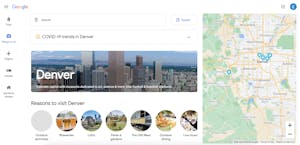
This guide breaks down Google Travel and identifies ways to use this tool to improve your online presence.
To use Google Travel, start by searching a destination, like Dubrovnik, Croatia. (You can also navigate to www.google.com/travel/ to see popular destinations or conduct your search from there). In the knowledge panel to the right of the search results, under “Plan a trip,” you’ll see a link to the Dubrovnik travel guide.
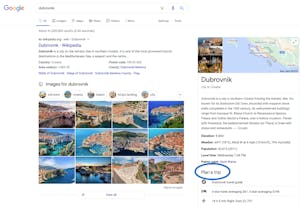
In the travel guide, navigate using the left-hand menu to search for Trips, Things To Do, Flights, Hotels, and Vacation Rentals.
Pro tip: For the purpose of getting your tours and activities featured on the site, you’ll want to focus on the Things To Do tab.

The Things To Do tab shows top sights based on things like:
There’s also a section at the bottom titled “See more while you’re there,” which features popular multi-day trip itineraries.
Click “See all top experiences” to get the full picture of what is featured in the travel guide.
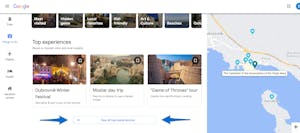
It’s important to note that the top experiences section not only features tours and activities, but also events, festivals, and popular things to do like waterfront dining or visiting a farmers’ market. While these are activities, they are not necessarily activities that require making a booking with a tour operator. More often than not, you’ll see a mix of activities like these as well as bookable tours and experiences.
When users click on one of these popular things to do, they’ll see a carousel of tour operators to choose from. They can click on the operator and see reviews, overall rating, hours of operation, and a link to the operator’s web results so that they can navigate to their website and complete a booking.
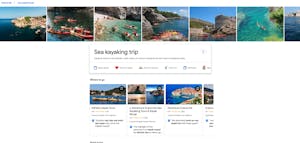
There’s no specific process for getting your tours and activities featured in the top experiences section. However, there are many insights to be gained from paying attention to which companies are featured.
As you may have noticed from browsing Google Travel for various destinations, the companies that show up in the top experiences section are usually those that have a high overall review rating, with a large number of reviews. It’s essential to manage your online reputation in order to regularly get good reviews and improve your ratings.
Get more review tips in our reputation management guides.
Another important aspect of being featured in your local travel guide seems to be the quality of your Google My Business (GMB) listing. Most of the operators seen in the travel guides have optimized GMB profiles that include high-quality photos, accurate and up-to-date information about hours, location, and services, interesting and helpful Google posts, and reviews.
Learn more about how to make your GMB profile stand out and troubleshoot any issues in our GMB guides.
Finally, being a well-established tour operator in your community gives you a good chance of getting featured on Google Travel, since the site relies on popular experiences and local insights when choosing companies. If your company is relatively new, becoming established in your local market is something that takes time. Some tactics to spread the word about our business include using local directories, marketing to your local communities, partnering with other nearby tour operators, and sponsoring local events like festivals, art openings, and concerts.
 Pro tip: Connect with other local tour operators by joining the FareHarbor Distribution Network.
Pro tip: Connect with other local tour operators by joining the FareHarbor Distribution Network.
When browsing the travel articles section of each travel guide, you might notice that Google tends to show articles from well established and respected sources like Culture Trip, The Telegraph, and Lonely Planet. Generally speaking, the featured articles usually come from travel publications or similar organizations. Topics typically cover lists of best activities, hotels, food, and points of interest.
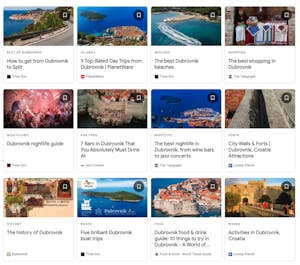
It will be difficult to get one of your blog posts to show up in this section. What you can do, however, is reach out to the specific authors and publications to discuss inclusion for your business. For example, if you notice an article about the best breweries in your area and you run brewery tours, you might reach out to see if that publication would be willing to mention your business in its article.
Even though there aren’t many direct actions you can take to position your business on Google’s travel guides, opportunistic tour operators can draw inspiration from the type of content included in the guide and use it to enhance their content strategy.
For example, take a look at the top sights in your location. Do you run tours or activities at any of those destinations? Make it clear that you do by emphasizing the destination in the tour name, mentioning it in key places on your website, and writing blog posts and social media posts about that popular sight/destination. Be sure to include information about any top sights by interest and use the keywords from the travel guide such as kid-friendly, outdoors, hidden gems, and more, since it’s clear people are searching for similar terms.
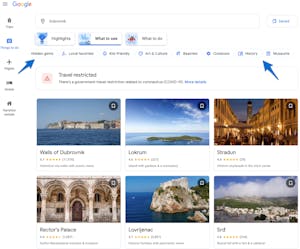
Under the top experiences tab, take a look at the tour operators listed there to see how their offerings and website compare to your own.
Finally, use the travel articles to get ideas for future blog posts. Pay attention to what the articles do a good job of covering, and where they could elaborate to provide additional information. Come up with your own blog posts that expand on the topics listed with more relevant information and stronger content.
Remember, when it comes to positioning your business on your local travel guide, results take time. There are many ranking factors at play, including how saturated your local market is, how well-known your business is, and the whims of Google in general. On the bright side, working on your reputation management, GMB listing, and overall content and blogging strategy are always valuable steps to improve your online presence and improve your SEO. Whether you end up on your local Travel Guide or not, following the steps in this guide will give you great results in terms of SEO and customer satisfaction.